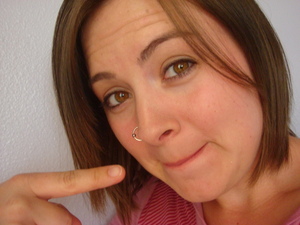Thinking about getting your nose pierced and want to know what to expect? Here, you will find out exactly what the process entails to help you decide if getting your nose pierced is right for you. Already have your nose pierced? Check out my article on What to Expect After Your Nose Piercing, found in my list of articles.
Getting your nose pierced.
First, and most important, make sure you are going to a nose piercing facility that uses all sterile instruments, gloves, etc. You do not want to mess with the possibility of infection, especially when it involves your face. Make sure you research the nose piercing facility and ask lots of questions before you go in.
The method with which the piercing facility does the nose piercing may vary, however most utilize the needle method. The piercing expert will first swab the inside and outside of your nostril to disinfect the area. He will then mark the place where the piercing will go. If you are having a hoop piercing, your nose piercing professional will temporarily place the hoop in position to ensure correct placement.
On the subject of hoop piercing: It is recommended that you get your nose pierced with a small hoop initially, instead of a stud. This is because the stud can sometimes get stuck and be required to be lanced out by a medical professional. For this reason, I personally decided that wearing a small hoop for two weeks wasn’t such a big deal. (Actually, once I got used to how it looked, I thought it looked pretty cute.) In addition, cleaning your nose piercing is much easier with a hoop because it can be rotated with ease. Also, piercing with a stud impedes thorough healing and prolongs the healing process. Seriously consider getting your nose pierced with a captive bead hoop instead of a stud if you are given the option.
Alright, back to your nose piercing. After the piercing placement is checked, your nose piercing professional will place a hollow tube inside your nose. This is done for two reasons: First, it creates a rigid surface so that the needle can poke through quickly and painlessly. Second, it creates a path through which the needle can travel so that it won’t poke the inside of your nose.
After the tube is in place, your nose piercing professional will quickly insert the needle and draw it through the tube, place your hoop or stud (you’ll feel some tugging at this point), and you’ll be done! In fact, it will take less time for the nose piercing to occur than it did for you to read the first part of this article. Immediately after your piercing, you may have a small amount of blood and swelling. It is also common for your eyes to tear up, so have a tissue handy.
What gauge do you pierce with?
Nose piercing are typically done with an 18 or 16 gauge needle. Anything smaller or larger is not going to work well for a nose piercing.
Does it hurt to get your nose pierced?
This is the most common question I have been asked about my nose piercing. It actually requires two answers. The initial piercing was no sweat. It was so fast, all I felt was a slight pinch and it was done with. I have had shots that were more painful than that. (I also joked with the nose piercing professional that nothing hurts in comparison to childbirth, which I have experienced twice now.) That being said, the recovery from the piercing was no walk in the park. But, in my opinion, the discomfort from the nose piercing was much less than the discomfort I felt when I got the cartilage in my ear pierced.
Cleaning your nose piercing.
It is imperative that you keep your nose piercing clean to avoid infection. Make sure that every time you touch your nose piercing, your hands are washed thoroughly. Avoid using saline solution, rubbing alcohol, antibiotic ointment, or hydrogen peroxide on your nose piercing. However, Bactine can be used (and I found that it seemed to help the healing process and avoiding infection). Clean your piercing at least two times a day. Take a cotton ball and soak it with warm water and mild soap. Place the cotton ball on the outside of your nose, and leave it there to loosen up the crustiness that will have collected on your stud or hoop. Repeat on the inside of your nose. If your nostrils are small and can’t fit a cotton ball inside your nose, use a Q-Tip that has water and soap on it to loosen the crust on the inside of your nose piercing. After you have cleaned off your jewelry, rotate it like you would an ear piercing. Use a Q-Tip to apply Bactine, if you so desire.
I hope this info has helped you in deciding whether or not a nose piercing is right for you. If you have any questions about my piercing experience, feel free to ask! Be sure to check out my What to Expect After Your Nose Piercing for tips on those first weeks of healing, including how to make it hurt less when you yawn and what to do about those pesky boogers.
Disclaimer: I am by no means a medical or piercing professional. This article is provided for informational purposes only.
